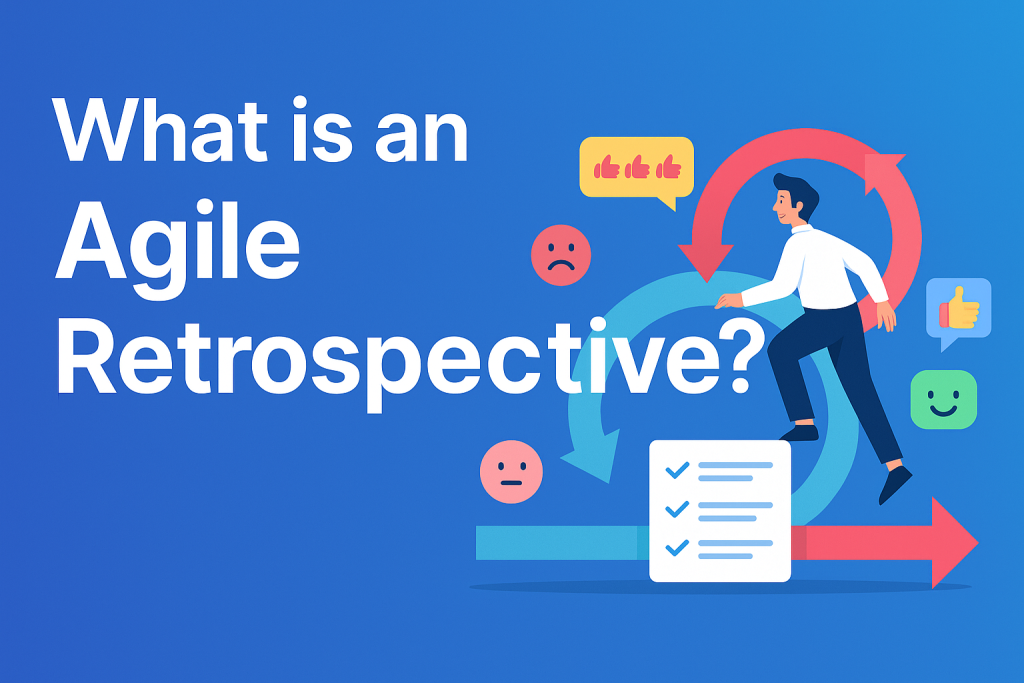If you’re working in Agile, you’ve likely heard the term retrospective tossed around — but what exactly is it, why does it matter, and how do you run a great one?
In this guide, we’ll break down the Agile retrospective, why it’s a key part of continuous improvement, how to make them actually useful (not just a box-ticking exercise), and how tools like SprintRetro can help bring your retros to life — with real data, team engagement, and measurable improvement.
📌 What is a Sprint Retrospective?
A retrospective (also called a sprint retrospective or Agile retro) is a regular team meeting held at the end of each sprint, where the team reflects on:
What went well
What didn’t go so well
What can be improved next time
In simple terms: it’s about pausing to inspect how the team is working, and finding ways to improve.
🧠 Why are retrospectives important?
Because without reflection, there’s no improvement.
Retrospectives help Agile teams:
- Continuously improve their processes
- Spot patterns and recurring issues
- Boost team communication and morale
- Prevent future roadblocks
When done well, retros become a force multiplier — small tweaks each sprint that add up to massive gains in velocity, quality, and team culture.
📆 When does a retrospective happen?
In Scrum, the retrospective happens at the end of every sprint (usually 1–4 weeks). It’s often the final event in the sprint, after the sprint review.
But retrospectives aren’t exclusive to Scrum. Kanban teams, product teams, and even leadership teams can benefit from regular retros.
🔧 How does a typical retrospective work?
There are many ways to run a retro, but a basic format includes:
- Set the stage — Create a safe space and outline the goal.
- Gather data — What happened during the sprint? Use both feedback and hard data.
- Generate insights — Identify patterns and pain points.
- Decide what to do — Choose action items for improvement.
- Close — Reflect, give kudos, and end on a positive note.
Popular formats include:
- Start / Stop / Continue
- Glad / Mad / Sad
- 4Ls (Liked, Learned, Lacked, Longed for)
😩 Why do some teams hate retros?
Let’s be honest. Not all retros are created equal.
You’ve probably been in those retros: lots of sticky notes, vague emotional check-ins, and then… nothing happens.
No data. No action. No change.
The truth is, many retros fail because they’re built on vibes instead of facts.
🚀 Make Your Retrospectives Data-Driven with SprintRetro
This is where SprintRetro comes in.
SprintRetro is a free Jira app that transforms your sprint retros into insight-rich, engaging experiences — directly inside Jira.
✅ Built-in Jira Metrics
No need to open 5 tabs. SprintRetro shows you:
- Sprint goals and completion rate
- Velocity trends
- Carryover and scope changes
- Cycle time breakdown
- Enhanced burndown with event markers
🤝 Team Engagement Features
- Add icebreaker questions to spark real talk
- Run unlimited polls with anonymity
- React with GIFs, emojis, and give Kudos
- Assign action items and track progress across sprints
🔐 Secure by design
SprintRetro is 100% Jira-native and built on Atlassian Forge. No data ever leaves your Jira instance.
💡 Think of it as your team’s Retrospective OS — built by Agile teams, for Agile teams.
🎯 Why SprintRetro Changes the Game
Most retrospective tools are:
- External platforms that don’t integrate well with Jira
- Static — no real-time data
- Expensive for growing teams
SprintRetro is:
- ✅ Free to use on Jira
- 📊 Powered by real sprint metrics
- ⚡ Designed for high-performance Agile teams
🏁 TL;DR — Retrospectives are essential. But only if they’re done right.
If your team is doing retros just to tick a box, it’s time to rethink.
Use real sprint data. Engage your team with meaningful conversation. Track actions across sprints. And make continuous improvement… actually continuous.
Try SprintRetro today — it’s free, fully integrated into Jira, and ready to turn your retros into real change.
Written by the team at Agile Pulse
Makers of PlanningPoker.org and SprintRetro

